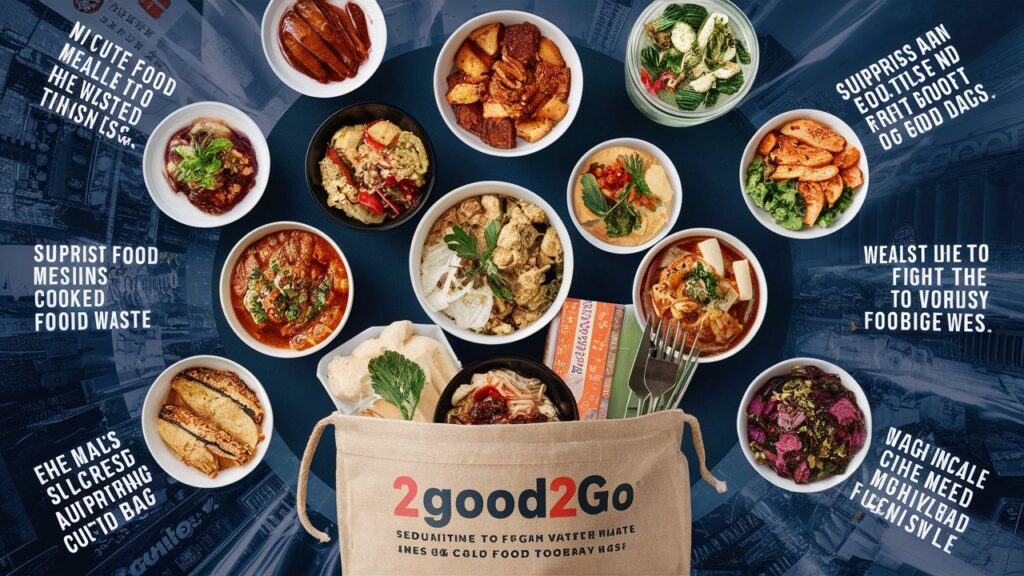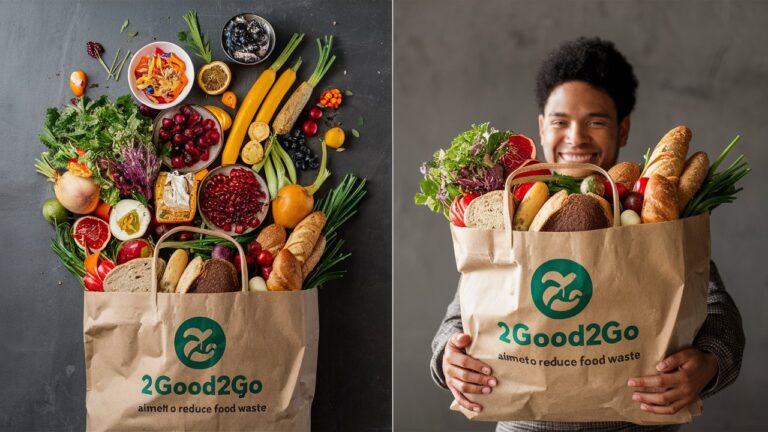Introduction
In a world grappling with the twin crises of environmental sustainability and economic inequality, a simple yet revolutionary idea has taken root, transforming how we perceive the food on our plates and the waste in our bins. Enter 2good2go, a movement and an app that has become synonymous with the fight against food waste. The concept is deceptively straightforward: connect consumers with restaurants, bakeries, and grocery stores that have surplus, unsold food at the end of the day, offering it at a significantly reduced price. This is not a charity; it is a smart, sustainable, and mutually beneficial transaction that is creating a powerful ripple effect. It challenges the very notion of what is considered “waste,” inviting us to see value where we once saw none. This article will delve deep into the world of 2good2go, exploring its core mechanics, its profound impact on our environment and wallets, and its role in fostering a new, more conscious consumer culture. We will unpack the journey from a store’s surplus to a consumer’s surprise, proving that saving the planet can be a delicious and rewarding experience.
The Core Concept of Surplus Food Redistribution
At its heart, 2good2go operates on a beautifully simple principle of surplus food redistribution. Every day, countless cafes, restaurants, bakeries, and supermarkets are faced with a logistical dilemma: they must have enough fresh food to meet customer demand throughout the day, but by closing time, a certain amount of perfectly edible, high-quality food remains unsold. This surplus, often comprising freshly baked pastries, prepared meals, sushi, fruits, and vegetables, traditionally had few destinations beyond a compost bin or a landfill. 2good2go disrupts this wasteful pipeline by providing a digital marketplace where this surplus is given a second chance. Businesses can list “Magic Bags” or “Surprise Bags” on the app, which consumers can then purchase and collect during a specific pickup window, typically at the end of the business day. This model is a win-win; businesses recoup a portion of their costs on food that would otherwise be a total loss, and consumers gain access to high-quality food at a fraction of the original price. It’s a pragmatic and scalable solution that addresses the inefficiency in our food supply chain directly at the retail level, turning potential waste into a valued commodity.
Navigating the User Experience: From Download to Delight
The user experience with 2good2go is designed to be intuitive, engaging, and convenient, mirroring the simplicity of other food delivery apps but with a unique, planet-positive twist. It begins with downloading the app and setting up a profile. Upon opening, the app uses your location to display a map or list of participating businesses in your vicinity. Each listing showcases the type of food offered—be it bakery items, groceries, or a hot meal—the original value, the discounted price (typically one-third of the original), and the crucial pickup time window. The element of surprise is a key part of the charm; while you know the category of food, the exact contents of your bag are a mystery until you collect it. Once you select a bag and complete the payment through the app, you receive a confirmation and simply need to arrive at the store during the designated pickup time to claim your order. This process not only makes sustainable shopping effortless but also adds an element of excitement, encouraging culinary creativity as users often receive items they might not have chosen themselves, thus broadening their palates and reducing food bias.
The Tangible Benefits for Consumers, Businesses, and the Planet
The impact of the 2good2go model is threefold, delivering tangible benefits to consumers, businesses, and the environment in a powerful, synergistic cycle. For consumers, the most immediate benefit is economic savings. Gaining several meals’ worth of high-quality food for a low price is a significant financial boon, especially in a time of rising living costs. Beyond the savings, there is the benefit of discovery, trying new local businesses and new food products they might otherwise overlook. For businesses, the advantages are equally compelling. Participating in the platform provides a new revenue stream from inventory that was previously a pure loss, improving their bottom line. It also serves as a powerful marketing tool, attracting new, cost-conscious, and environmentally aware customers to their establishment who may become regular, full-paying clients. Most profoundly, however, is the benefit to our planet. By diverting food waste from landfills, we dramatically reduce the production of methane, a potent greenhouse gas that is exponentially more harmful than CO2. Furthermore, we conserve the vast amounts of water, energy, and land that were used to produce that food, making 2good2go not just a transaction, but a meaningful act of environmental conservation.

Understanding the “Magic Bag” and its Role in Waste Prevention
The “Magic Bag” or “Surprise Bag” is the flagship product of the 2good2go experience and is central to its mission of waste prevention. This concept is ingenious because it directly addresses the unpredictability of retail food sales. A bakery cannot know precisely how many loaves of bread or pastries will sell on any given day, and a restaurant cannot predict exactly how many portions of a daily special will be ordered. The Magic Bag allows them to bundle this unpredictable surplus into a single, sellable unit without the administrative burden of managing individual item listings. For the consumer, this model fosters a mindset of flexibility and anti-perfectionism, challenging the supermarket culture where we expect to find exactly what we want, in perfect condition, at any time. It educates us that a bent carrot, a day-old croissant, or a sushi box from lunch service is still nutritious, delicious, and 2good2go. This shift in perception is crucial for long-term waste prevention, as it builds a community of consumers who value substance over superficial perfection and understand that saving food is a dynamic and rewarding process.
Conclusion: A Movement Towards a Conscious and Waste-Free Future
2good2go is far more than a clever app for finding a cheap meal; it is a beacon in the growing movement towards a more conscious and sustainable global food system. It demonstrates that systemic change does not always require complex legislation or grand technological breakthroughs; sometimes, it simply requires a smarter way of connecting existing supply with latent demand. By empowering individuals to make easy, affordable, and positive choices, it builds a collective force against the staggering problem of food waste. Each Magic Bag collected is a small victory—a few kilograms of CO2 saved, a business supported, and a household nourished. As this model continues to expand and inspire, it sows the seeds for a cultural shift where valuing our food resources becomes the norm, not the exception. It proves that when it comes to saving our planet, the most powerful tool we have is the choice we make on our phones and our plates, one surprise bag at a time.
Frequently Asked Questions (FAQs)
Is the food from 2good2go safe to eat?
Absolutely. The food offered through 2good2go is always fresh and perfectly safe to eat. Partner businesses are required to adhere to all local food safety regulations. The food is surplus, not spoiled. It consists of items that were made fresh that day but remained unsold, such as baked goods from a morning batch, daily lunch specials, or sushi that cannot be sold the next day. The platform is built on a foundation of trust and quality, ensuring that consumers receive food that is truly “too good to go to waste.”
What kind of stores participate in the 2good2go program?
The diversity of participating stores is one of the platform’s greatest strengths. You can find everything from high-end restaurants and popular local cafes to major supermarket chains, bakeries, hotels, and juice bars. The common thread is that they all deal in fresh food that has a limited shelf-life. This variety means that a user can experience a wide range of culinary offerings, from a bag of assorted groceries and pastries to a ready-to-eat gourmet meal.
Can I choose what’s in my Magic Bag?
The core concept of the Magic Bag is the element of surprise, so you generally cannot choose the specific items inside. You select a bag based on the store and the food category (e.g., “Bakery,” “Groceries,” “Hot Meal”). This is what allows businesses to efficiently offload their unpredictable daily surplus. However, many users find this to be part of the fun, as it encourages them to try new foods and get creative in the kitchen with ingredients they might not have picked themselves.
What if I have dietary restrictions or allergies?
This is an important consideration. Because the contents of the bags are a surprise, 2good2go may not be the most reliable option for people with severe, life-threatening allergies. However, the app often allows businesses to list dietary information for their bags, such as “Vegetarian,” “Vegan,” or “Contains Gluten.” It is always recommended to read the bag description carefully and, if in doubt, contact the store directly before purchasing to inquire about the possibility of accommodating your specific needs.
How does 2good2go actually help the environment?
The environmental impact is direct and significant. When food waste ends up in a landfill, it decomposes without oxygen and produces methane, a greenhouse gas that is over 25 times more potent than carbon dioxide in trapping heat in the atmosphere. By rescuing a “Magic Bag,” you are directly preventing that food from contributing to methane emissions. Furthermore, you are saving all the resources—water, land, fertilizer, and energy—that were used to grow, harvest, transport, and package that food. It’s a powerful act of conservation that reduces your personal carbon “foodprint.”
